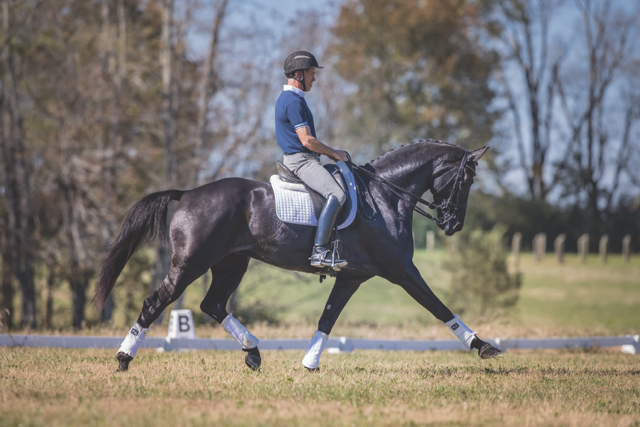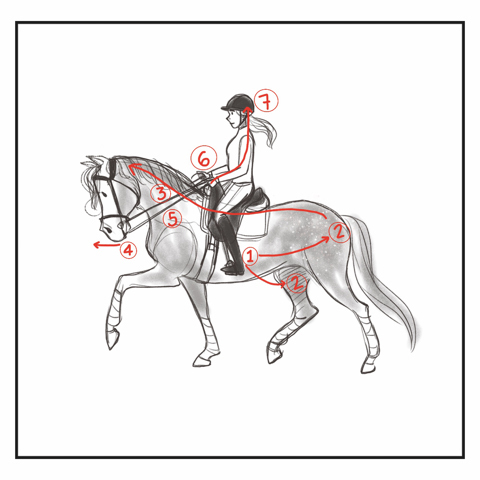How to Ride the Horse You Thought You Bought

The following excerpt is from "How to Ride the Horse You Thought You Bought," by Anne Buchannan, and published by Trafalgar Square Books.
In this excerpt, trainer and educator Anne Buchannan explains bit contact connection and why it matters for true collection and healthy movement.
Connection Theory: The Circuit
Connection between horse and rider is dependent on a “circuit” that unites both bodies into a single unit. A circuit is a circular journey beginning and ending at the same place. In electronics, a circuit is a closed path that allows electricity to flow from one point to another. In riding, the horse’s forward energy is analogous to electricity, and the horse’s hindquarters serve as the start and end point of this circular path: The horse pushes from behind, giving the rider a connection with the horse through the reins, allowing her to use them to influence the horse as she encourages him to shift his weight back onto his hind legs. This causes the joints of the hind end to bend deeply so that there is more spring when they straighten, resulting in more power for the next push forward, completing the circuit and maintaining the connection through the next stride. The horse won’t lose energy if this circuit is maintained and the flow isn’t broken; thus, the rider won’t need to constantly make corrections or re-establish energy.
The horse’s hind end propels the entire horse forward, taking the bit in the mouth forward along with him. The horse’s momentum, causing the bit to advance, exerts force on the reins and thus the rider’s hands. Connection occurs as a result of this push from the rear. In this way, the reins act as “data cables,” informing the rider about the amount of force (or lack thereof) emanating from the horse’s hind end and the horse’s willingness to make contact. It’s great if the horse takes the reins forward and downward. When the reins are too loose, however, this “data” informs the rider’s hands that the horse isn’t moving forward enough and needs to be pushed to re-establish that connection.
Issues with connection are rooted in “slackness” in the reins. Either the horse or the rider can introduce slack to the scenario, but it is the horse that must advance the bit/reins, as requested by the rider with the cue for forward. However, humans are driven by a primal inclination to secure looseness in the reins by pulling back on them, which interferes with the horse’s forwardness, suppleness, energy, and good nature. The result is what is referred to as "riding front to back," while the preferred method is "back to front" (where the horse is pushed forward into the bridle, as I’ve described).
Why does this matter so much? It matters because the powerful hindquarters are the driving force behind a horse’s forward motion. As the back of the horse propels the front of the horse forward, the sensation of the bit being carried forward with him is experienced as positive tension on the reins, created by the horse. In this way, the power generated behind is transmitted to the rider’s hands...if the hands are duly prepared to receive it. Receiving and maintaining this energy is connection. When connection exists, the channel for communication between horse and rider is open.
However, when the horse is not forward or when your hands and reins are slack, little energy is generated, and the energy that is generated is wasted because there is nothing to capture it and use it to produce more. Consider the energy flow in a power plant: coal combustion and nuclear reactions produce heat. This heat boils water to create steam, which is then channeled into a cylinder to spin a turbine, generating electricity. This electricity is stored in a "grid," which consists of substations, transformers, and power lines that connect the electricity producer to the consumer who uses it to turn on the lights or operate an air conditioner. Similarly, the hindquarters (“turbine”) of the horse push off the ground and send energy through the horse, where it is caught in the hands and body of the rider (the “substation”), who then channels that energy through aids (“power lines”) to whichever maneuver the horse will do. However, if the rider doesn’t harness or channel the energy, it dissipates like steam in the wind, and is lost. Connection is lost.
How Do You Catch the Circuit Energy?

Olympic dressage rider Jane Savoie provided an effective analogy to help understand how to use the hands to catch the energy generated by the hindquarters of the horse: Think of the reins, or your connection, like a balloon. Your driving aids push the horse forward, like air inflating a balloon. When you feel the horse produce tautness on the reins, “closing your outside hand in a fist puts a knot at the end of it to keep [the balloon] full of air.” Keeping the balloon full of air is what keeps the connection; connection is the only thing that enables you to communicate with the horse. To keep this “full balloon feeling,” you must keep the horse moving energetically forward so that his momentum maintains the connection. However, the horse shouldn’t go faster; he needs to go bigger. Think of the rein in your outside hand like a barrier. He goes into the barrier, like he’s trotting with his forehead against a wall. Then, you have potential energy to tap into for anything. He needs to stay yielding and soft into your inside hand, and his body comes up as you ask for more effort. This is a wonderful feeling—like cantering up a hill—because the horse is responsive and willing because he is able. He’s not plowing through the bridle and pulling downhill.
To encourage your horse to remain forward, put your hands slightly forward, so he has to push and reach forward “to arrive at them.” To encourage him to arrive at your hand, you must exert the same amount of force with your seat and legs as you give with your hands. When your driving aid and your pushing hands aren’t equal, slack is introduced: if you drive too much and don’t catch it, the energy escapes out the front like air leaking from a balloon; if you hold too much and don’t drive enough, the horse slows down, backs off the bridle, and loses energy, like tying a knot in that balloon before you inflate it. The latter is front-to-back riding, where pulling on the front “chokes off” the energy from the back. The hind legs never have the opportunity to generate impulsion.
Don’t be tempted to adjust slack yourself; doing so causes the horse to slow down, lose energy, and lose the ability to communicate. Fiddling with the reins distracts you from focusing on forward, disrupts your position and allows the horse to get away with not taking the bridle forward. Make the horse do it. The more you cover for the horse, the more he will exploit slack. As suggested by Jane Savoie, say to the horse, “Go forward until you meet my hand, and then stay there. My hand is not going away and you need to get used to that.” In this way, you keep the balloon filled with air.
The forward press into the hand is as vital and obligatory to riding as treading water is to swimming. To accomplish this, the rider must maintain a firm core while allowing her legs to drape against the horse’s side. You must maintain the horse’s energy and connection through your seat, legs, and hands. If you allow your position to deteriorate, the energy will dissipate like air from a leaking balloon.

The circle/cycle of energy originates with the (1) rider's legs (input to horse), which induce the horse to move his (2) hind legs (output). When the horse's hind legs propel the (3) entire body forward, (4) the bit moves forward in space along with the horse. When the horse moves forward enough in response to the leg stimulus, he will pick up the slack in the (5) reins (as long as they aren’t too long) as a result of the bit's forward movement. The (positive) tension on the reins further increases as the horse extends his neck due to the lifting of the spine caused by the hind legs stepping for- ward under his body. The rider can then feel this connection in the reins with (6) her hands (output of horse is input to rider) and determine (7) from this input whether to send the horse forward with (1 again) the leg or to ease off on the driving aid.
This excerpt is is reprinted with permission from Trafalgar Square Books. Purchase your copy here.














